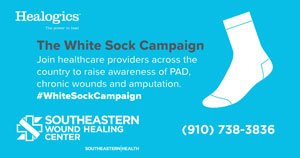Wound Healing Center Raises Awareness of Peripheral Artery Disease

Peripheral Artery Disease (PAD) is a condition that develops when the arteries, that supply blood to the internal organs, arms and legs, become completely or partially blocked as a result of atherosclerosis. Throughout September, Southeastern Wound Healing Center observes PAD Awareness Month to educate the community that this condition affects between eight and 12 million people in the U.S., contributes to difficult-to-heal wounds, and is associated with amputation. Though some symptoms may be serious, an astonishing 40 percent of people with PAD do not experience any symptoms.
Southeastern Wound Healing Center, an affiliate of Southeastern Health and a member of the Healogics® network, treats chronic wounds with underlying conditions of the disease as well as performs non-invasive tests for PAD. The center also counsels patients on how to manage the illness which can, if left untreated, lead to lower limb amputation and death.
“Despite the pandemic, it is still important to be aware of other health issues such as PAD and related wounds and not delay treatment, said SWHC Program Director Kathy Hansen. “Our staff are ready and able to take care of patients safely.”
In addition to chronic wounds on the toes, feet or legs, the experts at SWHC give the following risk factors and symptoms of PAD:
- Those who smoke or have a history of smoking have up to four times greater risk.
- One in every three diabetics over the age of 50 is likely to have the disease.
- People with high blood pressure, high blood cholesterol or a personal history of vascular disease, heart attack, or stroke are at greater risk.
- As you get older the risk increases since the disease develops gradually.
- While some people dismiss it as a sign of aging, nearly everyone with PAD is unable to walk as fast or as far as they could before.
- A typical sign is experiencing fatigue or a heaviness in the limbs or cramping in the thigh or calf after walking or climbing stairs and then feeling better after resting.
- Leg or foot pain may cause trouble sleeping for those with PAD.
- The skin of the feet may change color and become pale or turn blue.
- Toenails that do not grow as well as before and decreased hair growth on the toes and legs may be another symptom.
Advanced PAD results in delayed wound healing and greater risk for limb loss. Timely detection and treatment of any wound can reduce risk of amputation and improve quality of life. SWHC offers advanced wound care treatment, technology and research. That means patients heal faster than those who receive only generalized wound care.
For more information on managing PAD and treating chronic or infected wounds, contact SWHC, which is located at 103 W. 27th Street in Lumberton, at (910) 738-3836.